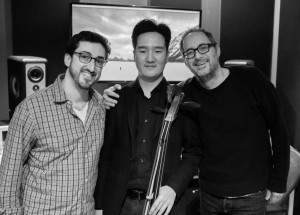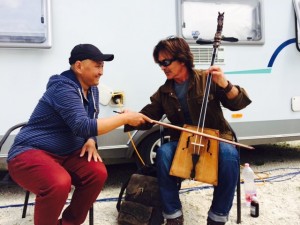This was a fine week for the hardworking Marco Polo team, our loyal ‘Golden Horde’ as we learned that the series was ranked #2 in digital TV, only behind ‘Orange is the New Black.” Also came in at #3 in all TV shows–a quantum jump of 48 spots from the week prior — only behind OITNB and some show called “Game of Thrones.” Want to say congratulations to all, from the bold and brilliant writers room to the amazing cast (the most ethnically diverse in TV history), crew, and every single department and component of this massive nomadic production. We are family.
Amongst the fun and rewarding feedback and reviews on social media this week, I’ve been hearing a lot about the music in Season 2, and getting as many questions about it. Many are fascinated (or ‘haunted’ as a few have said) by the Mongolian throat-singing, the unusual Silk Road instrumentation, and the way that it all blends into an edgy, modern cinematic score.
As with every facet of the series — from unique costume design to the 13th century sets — the music of “Marco Polo’ is rooted in history while pushing that authentic soul toward new, creative ideas (through the eyes of the outsider Marco Polo). Daniele Luppi’s main title music captures the ‘East meets West’ theme with a haunting nod to Morricone — using Mongolian throat-singing in place of the chanting man-choir you remember from Leone’s spaghetti westerns. For those who are intrigued by the cycle of influence between Kurosawa and Leone, and also the way that some vintage Hong Kong movies have cannibalized spaghetti western soundtracks (sometimes so bad it’s great), this was a musical idea I’ve long been excited about. So I was thrilled when it was nominated for an Emmy back in Season One, and that it continues to excite folks in Season 2.
Periodically in our show, the authentic sounds of renowned Mongolian folk-rock bands Altan Urag and Khusugtun can be heard, adding a chilling authenticity and tribute to Mongolia. In Season One, the end credit music featured an Altan Urag epilogue track for each episode. All of this under the direction of our super-cool music supervisor Jim Black and post-prod expertise of director Dan Minahan (and our great editing and sound team).
But who are the Marco Polo composers who have brilliantly designed and created the original compositions and cues that drive the drama and adventure of ‘Marco Polo’? The musical storytellers on our creative team? Meet Peter Nashel and Eric Hachikian, two masterful musicians of classical pedigree and no strangers to film scoring.
What’s incredibly impressive is that these guys came onto Season One only days away from our first episode music delivery date. The way that they immersed themselves into the characters, background history, the complex multicultural traditions of our story world — not to mention researching ancient Silk Road instrumentation — under the guns, was a thing of wonder. As a musician myself, I fell in love with these intrepid cats and their commitment to such an epic challenge. They’re not only musician’s musicians, they’re musicologists and truly go deep into the history of the instrumentation — and then they bend it, twist it, amplify it, bust it open, and create a seamless blend of East and West that informs not just mood but character.
“What was so cool for us about this show was the range of storytelling,” the guys told me recently. “It let us blend modern cinematic score elements with traditional indigenous instruments”. This season, Peter and Eric also felt fortunate to collaborate with a premier Morin Khuur musician, Jigjiddorj Nanzaddorj, who has twice been named the state laureate artist of Mongolia.
 The Morin Khuur, also known as the ‘horse head fiddle’ is one of the most important traditional instruments of the Mongols. The instrument, originally fashioned in ancient times from an airag (fermented mare’s milk alcohol) ladle is a wooden-framed sound box with two strings that run up to a tuning scroll that’s carved in the form of a horse head (see the pic of me trying to play one on location). The bow is loosely strung with horse hair.
The Morin Khuur, also known as the ‘horse head fiddle’ is one of the most important traditional instruments of the Mongols. The instrument, originally fashioned in ancient times from an airag (fermented mare’s milk alcohol) ladle is a wooden-framed sound box with two strings that run up to a tuning scroll that’s carved in the form of a horse head (see the pic of me trying to play one on location). The bow is loosely strung with horse hair.
Peter and Eric went beyond just using the traditional acoustic instrument though. To match the Khan’s presence, they amplified the Morin Khuur, and in some cases, processed it to match Benedict Wong’s larger than life performance of the Khan of Khans. They also used the amplified morin khuur in the Hundred Eyes Christmas Special (Hundy’s origin story). You might remember it as that haunting, building, bad-ass doppler effect when Hundred Eyes is wrapping his chain whip around his hand as he prepares to do battle. Few have ever pushed the horse head fiddle to that amplified and processed creative extreme, and the result is goose-bump stuff.
And then there’s the thrilling battle score from Episode 10. Come on inside Peter and Eric’s studio for a minute and watch the boys at work with Master Nanzaddorj and the mighty morin khuur:
 Season 2 also allowed Peter and Eric to continue their exploration of the instruments from China like the Guzheng, Yangqin, Pipa, Xiao and Bawu. They touched on the Persian roots of the Silk Road as well with the Kanun, Oud, and Duduk, and explored a choir singing Latin text and ancient chants for the Christian story lines. Musically, they had a particular interest in developing Ahmad’s Uzbek lullaby throughout the episodes. This music motif is as pivotal as any dialogue or plot point — and the boys, working with Wild Jim Black, killed it.
Season 2 also allowed Peter and Eric to continue their exploration of the instruments from China like the Guzheng, Yangqin, Pipa, Xiao and Bawu. They touched on the Persian roots of the Silk Road as well with the Kanun, Oud, and Duduk, and explored a choir singing Latin text and ancient chants for the Christian story lines. Musically, they had a particular interest in developing Ahmad’s Uzbek lullaby throughout the episodes. This music motif is as pivotal as any dialogue or plot point — and the boys, working with Wild Jim Black, killed it.
So, meet the musicians who have truly infused the new season of Marco Polo with an effective and fascinating score that is as interesting in its conception and historical background as the source inspiration itself. Every time I hear it, there’s another layer, another bold turn, another reference to region and roots, and I feel lucky that we found these guys — another part of the top-notch dream team that is the Marco Polo production.
Turn on the 4K and crank up the volume.









